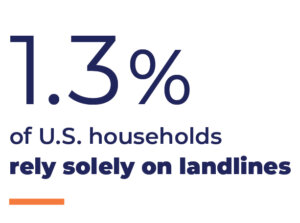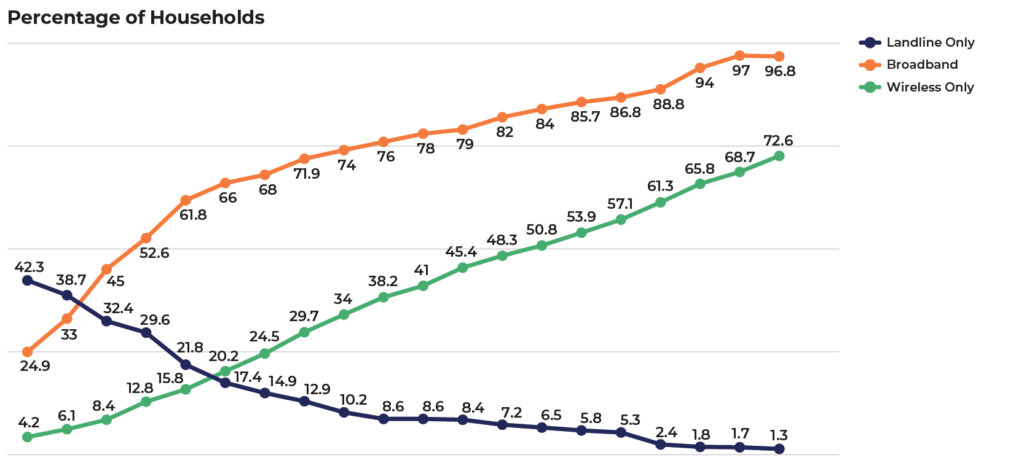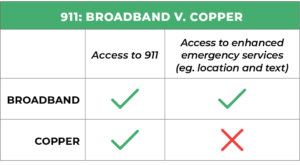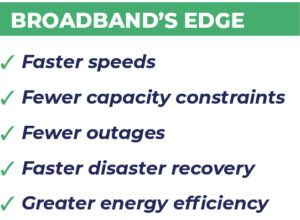A Vital Step Toward Universal High-Speed Broadband
For decades, copper landlines served as the original conduit for connecting our nation. But the emergence of high-speed broadband and the country’s push to ensure modern networks reach every community have opened up a far wider range of opportunities—from new work, health care, and education choices to enhanced emergency services and resilience in the wake of natural disasters.
Consumers have overwhelmingly chosen a broadband future. As a result, less than two percent of U.S. households today rely solely on landline connections. Yet outdated regulations force broadband providers to prop up aging copper networks at the expense of focusing investment on achieving a connected broadband nation.
 Our Take
Our Take
With the transition to next-generation broadband networks moving forward, regulations written for a more analog world have overstayed their usefulness. They now actively undermine the national effort to connect all Americans to broadband’s many opportunities.
Many states have met the moment by embracing modern rules that focus investment on high-speed broadband infrastructure. VoIP, wireless, and other modern technologies can ensure continuity of service, including access to 911.
Aging copper networks are costly and time-consuming to repair. They are far slower and more vulnerable to outages and capacity constraints. In short, copper networks are the poster child for why broadband’s progress is so important. Consumers have overwhelmingly moved on and embraced broadband. Federal and state policies should follow their lead.
Consumers Made the Tech Transition, Our Policies Should Follow [2]

Connecting to 911
Tech modernization skeptics often cite the well-meaning but misguided concern that those who rely on copper networks will lose service, including 911 access. This is not the case. Customers will be able to keep their voice services. They will simply be powered by more reliable broadband and wireless networks. Consumers will also have not only basic 911, but enhanced emergency services that help first responders locate callers and, in some cases, communicate via text when it’s not safe to talk.

Policymakers’ Choice: Save the Stagecoach or Embrace the Car?
Copper networks, designed before the internet era, are expensive to maintain and offer slower speeds. Replacement parts for this aging infrastructure are increasingly hard to obtain, making repairs and restoration of service more challenging, lenthly, and costly.
Rather than requiring broadband providers to continually fix the wooden wheels on a stagecoach, modern policies should help focus investment on extending and upgrading modern networks throughout the nation.

Bottom Line
Consumer demand is driving the transition to universal broadband. But outdated regulations are pulling us back – siphoning off time and resources away from the goal of universal broadband to maintain old copper networks rather than speeding reliable, high-speed internet to everyone. We need a modern regulatory environment that advances rather than undercuts tech modernization. Achieving the shared goal of universal broadband requires a shared determination to look to the future, not remain stuck in the past.
[2]
Landline Only:
Wireless Substitution: Early Release of Estimates from the National Health Interview Survey
Broadband:
www.statista.com/statistics/187145/number-of-fixed-broadband-subscriptions-in-the-united-states-since-2000/
www.statista.com/statistics/183635/number-of-households-in-the-us/
Wireless Only:
Wireless Substitution: Early Release of Estimates from the National Health Interview Survey
The post Network Modernization appeared first on USTelecom.
This is a companion discussion topic for the original entry at https://www.ustelecom.org/network-modernization/